M56 Globular Cluster
Click image for full size version
March 24, 2016; Journal of the Royal Astronomical Society of Canada, June 2016
 Globular cluster M56, in Lyra, the Harp, lies about 33,000 light years away and its stars have the mass of about 230,000 times that of the Sun. It sometimes goes unnoticed because it shares the general area of the sky with a few other iconic objects: the Ring Nebula (M57), the “Double Double” – a pair of tight, bright, white double stars – and Vega, the 5th brightest star in the sky. One of the things I like about globular clusters is how different they all are from each other. This one resolves quite well right to the core, and is set in a rich Milky Way star field. Another thing I find interesting about these objects is that they tend to be very old. This one is estimated to be 13.7 billion years old, and may have been captured by the Milky Way from another galaxy. Its orbit around the Milky Way is retrograde, meaning it is in a direction opposite to most other similar objects.
Globular cluster M56, in Lyra, the Harp, lies about 33,000 light years away and its stars have the mass of about 230,000 times that of the Sun. It sometimes goes unnoticed because it shares the general area of the sky with a few other iconic objects: the Ring Nebula (M57), the “Double Double” – a pair of tight, bright, white double stars – and Vega, the 5th brightest star in the sky. One of the things I like about globular clusters is how different they all are from each other. This one resolves quite well right to the core, and is set in a rich Milky Way star field. Another thing I find interesting about these objects is that they tend to be very old. This one is estimated to be 13.7 billion years old, and may have been captured by the Milky Way from another galaxy. Its orbit around the Milky Way is retrograde, meaning it is in a direction opposite to most other similar objects.
The data for this image were collected in May 2013, almost a year before this website was launched, but I don’t think I have distributed it previously.
Tekkies:
SBIG STL-11000M camera, Baader LRGB filters, 10″ f/6.8 ASA astrograph, MI-250. Guided with STL-11000’s internal guider, Focus with FocsMax and all controlled with CCD Commander. Acquistion, guiding and calibration using Maxim-DL. Registration, integration and all processing in PixInsight. Shot from my SkyShed in Guelph, Ontario. Average transparency and average seeing.
12x10mL and 5x3mL unbinned and 10x3m R, G and B binned 2×2. (total 3hr45m).
RGB
Creation and cleanup: The R, G and B masters were processed with DynamicBackgroundExtraction and combined with ChannelCombination. The resulting RGB image was cropped and processed with BackgroundNeutralization and ColorCalibration.
Linear Noise Reduction: MultiscaleLinearTransform was used to reduce noise in the background areas of the RGB image. Layer settings for threshold and strength: Layer 1: 3.0, 0.5 Layer 2: 2.0, 0.39 Layer 3: 1.0, 0.25 Layer 4: 0.5, 0.1. The MLT internal mask was used to protect high signal areas.
Stretching: HistogramTransformation was applied to make a pleasing yet bright RGB image.
Luminance
Creation and cleanup: The two L masters (10m and 3m subs) were each processed with DBE and then combined using the HDRCombination tool.
Deconvolution: A copy of L was stretched to use as a deconvolution mask. A star mask was made from unstretched L to use as a local deringing support. Deconvolution was applied (50 iterations, regularized Richardson-Lucy, external PSF made using DynamicPSF tool with about 20 stars; local deringing at 80% and global dark deringing at 0.01).
Linear Noise Reduction: MultiscaleLinearTransform was applied to reduce the noise. Layer settings for threshold and strength: Layer 1: 3.0, 0.6 Layer 2: 2.0, 0.5 Layer 3: 1.0, 0.4 Layer 4: 0.5, 0.15. The MLT internal mask was used to protect high signal areas.
Stretching: HistogramTransformation was applied to make an image with similar brightness to the RGB image. TGVDenoise was applied and the image was re-stretched to reset the black point.
Combining L with RGB:
ImageRegistration was used to align the RGB to the L image. The luminance channel of the RGB image was extracted, processed and then added back into the RGB image as follows:
1. Set RGB channels equal using RGBWorkingSpace.
2. Extract luminance from the RGB image.
3. Apply LinearFit using L as the reference.
4. Use ChannelCombination in Lab mode to replace the RGB’s luminance with the fitted luminance from step 2.
5. LRGBCombine was then used to make a LRGB image using L as the luminance channel.
Final Processing
A copy of the LRGB image was processed with HDRMultiscaleTransformation (6 pixel scale), and blended with the original 1:1. Contrast, brightness and saturation were adjusted in several iterations with the Curves tool, with separate adjustments for background and stars using masks. Background neutralization was used to remove a slight red cast in the background.
Image scale is about 1.1 arcsec per pixel for this camera / telescope combination.

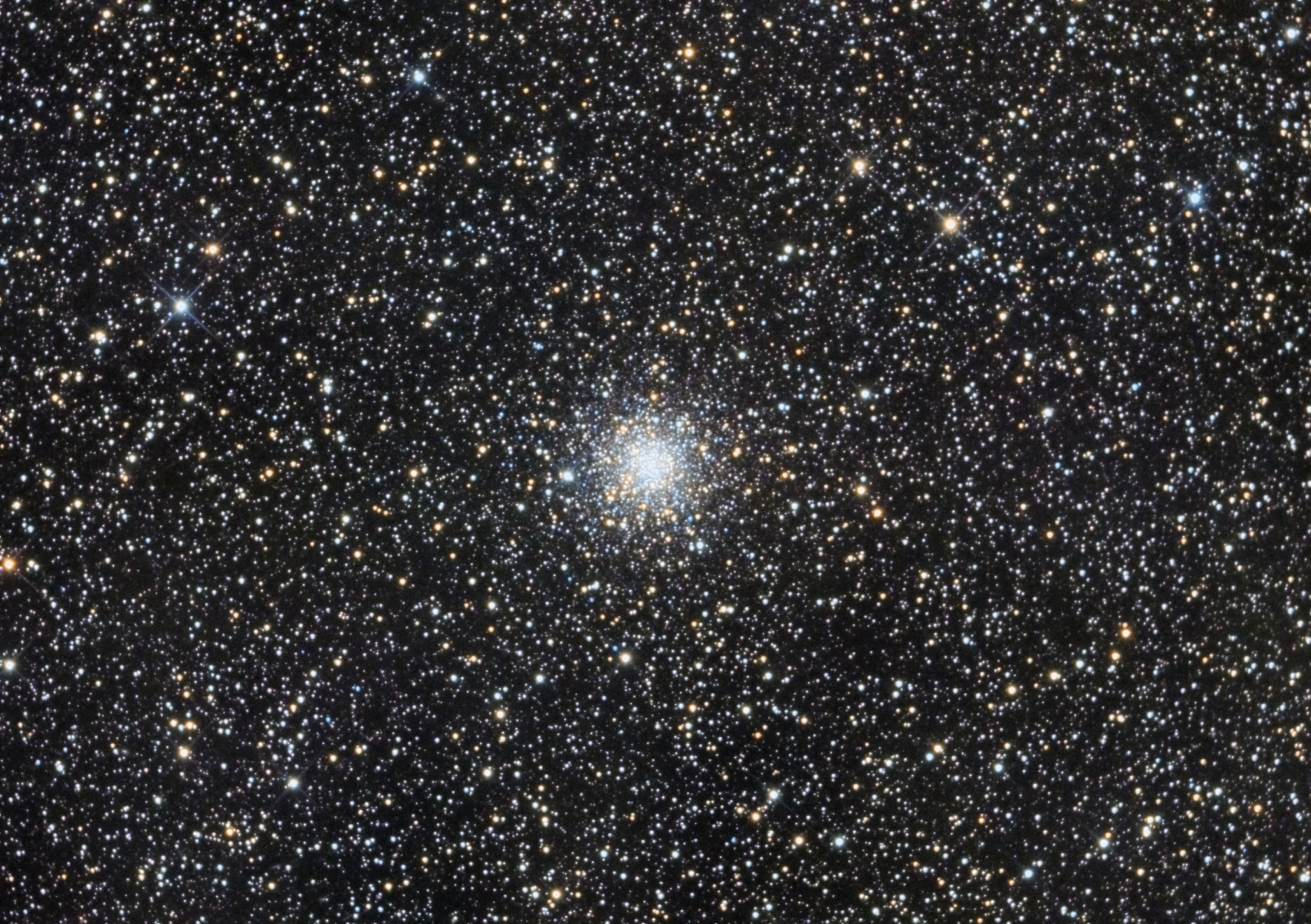
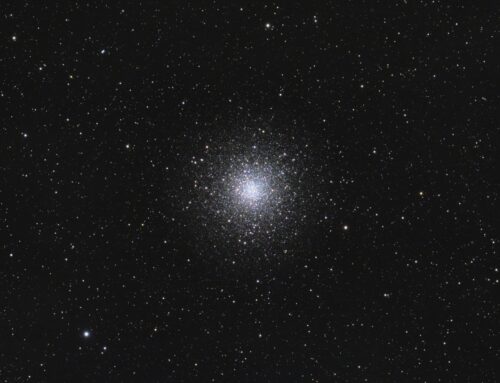
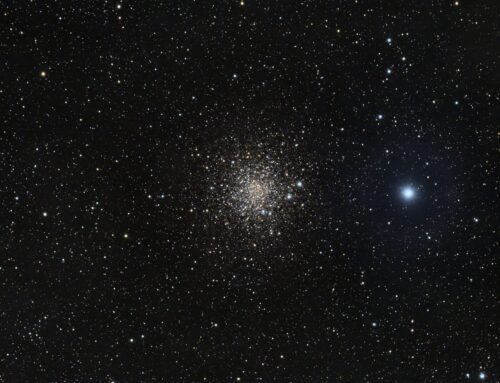

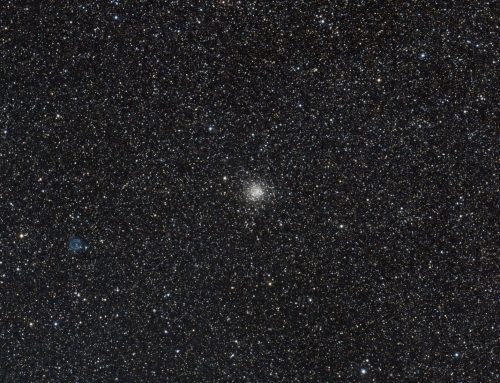
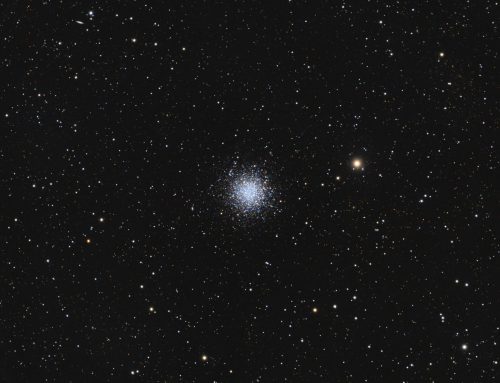
Leave A Comment